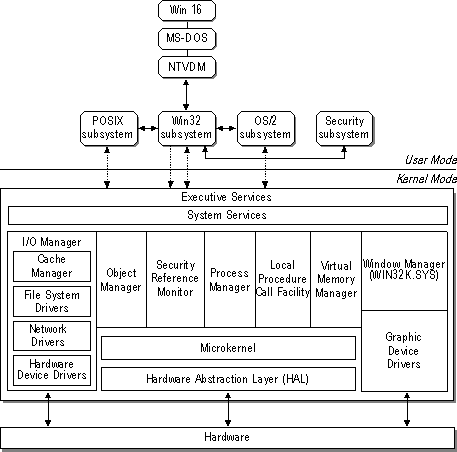
In modern operating systems, applications are kept separate from the operating system itself. The operating-system code runs in a privileged processor mode known as the kernel, and has access to system data and hardware. Applications run in a nonprivileged processor mode known as user mode, and have limited access to system data and hardware through a set of tightly controlled APIs.
One of the design goals of the Windows NT operating system was to keep the base operating system as small and efficient as possible. This was accomplished by allowing only those functions that could not reasonably be performed elsewhere to remain in the base operating system. The functionality that was pushed out of the kernel ended up in a set of nonprivileged servers known as the protected subsystems. The protected subsystems provide the traditional, operating-system support to applications through a feature-rich set of APIs.
This design results in a very stable base operating system. Enhancements occur at the protected subsystem level. New protected subsystems can even be added without modification to either the base operating system or the other existing protected subsystems.
The executive is the kernel-mode portion of the Windows NT operating system and, except for a user interface, is a complete operating system unto itself. The executive is never modified or recompiled by the system administrator.

Figure 1.1 Windows NT operating system architecture
The executive is actually a family of software components that provide basic operating-system services to the protected subsystems and to each other. The executive components are listed below.
The executive components are completely independent of one another and communicate through carefully controlled interfaces. This modular design allows existing executive components to be removed and replaced with ones that implement new technologies or features. As long as the integrity of the existing interface is maintained, the operating system runs as before. The top layer of the executive is called the System Services, which are the interfaces between user-mode protected subsystems and kernel mode. For details on the executive and its components, see Chapter 1, "Windows NT Architecture," in the Microsoft Windows NT Workstation 4.0 Online Resource Guide.
The protected subsystems are user-mode servers that are started when Windows NT is started. There are two types of protected subsystems: integral and environment. An integral subsystem is a server that performs an important operating system function, such as security. An environment subsystem is a server that provides support to applications written for or native to different operating system environments, such as OS/2.
Windows NT currently ships with three environment subsystems: the Win32® subsystem, the POSIX subsystem, and the OS/2 subsystem.
The Win32 (or 32-bit Windows) subsystem is the native subsystem of Windows NT. It provides the most capabilities and efficiencies to its applications and is the subsystem of choice for new software development. The POSIX and OS/2 subsystems provide compatibility environments for their respective applications and are not as feature-rich as the Win32 subsystem.